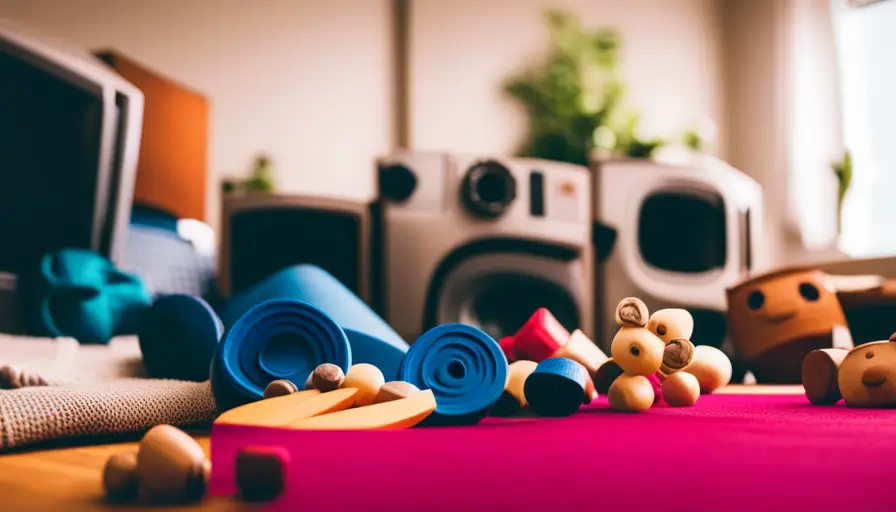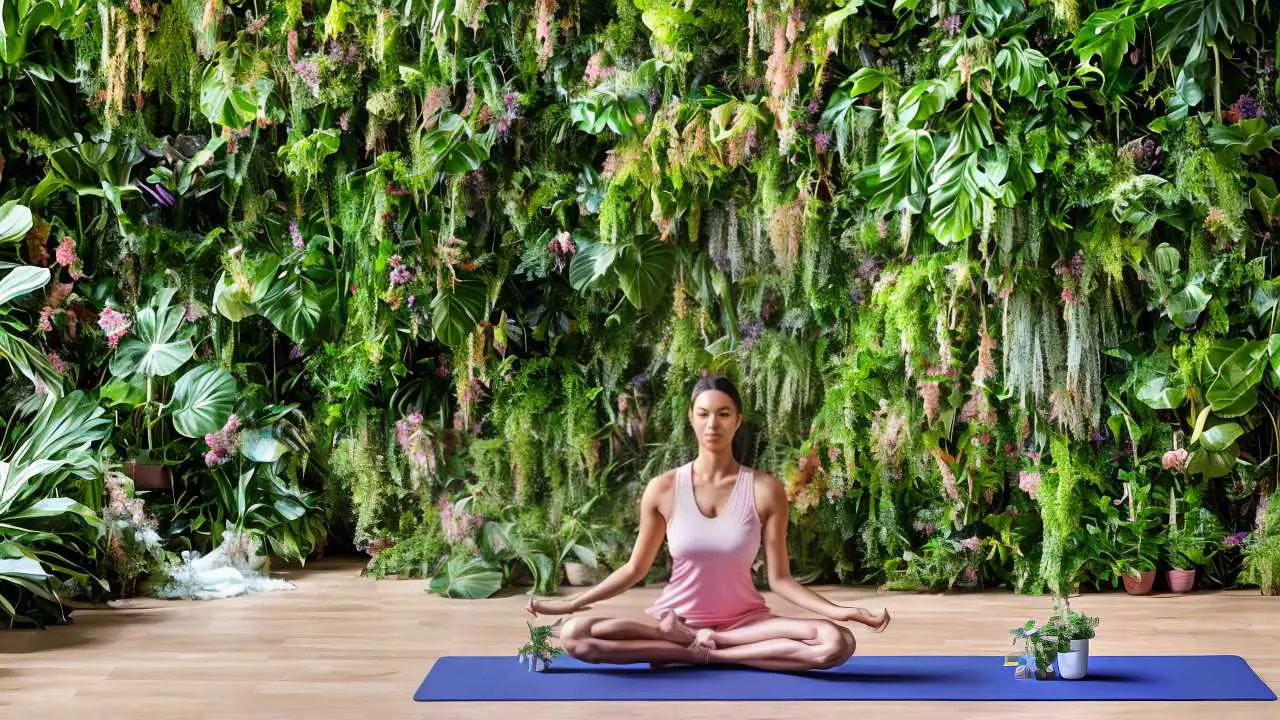Do you long for the freedom to practice yoga in the comfort of your own home? While the idea of unrolling your mat and flowing through poses sounds alluring, there may be barriers obstructing your path.
Some common obstacles to practicing yoga at home include lack of motivation or discipline, distractions from household chores or family members, limited space, lack of knowledge or guidance on proper techniques, and difficulty in creating a peaceful and serene environment.
But worry not, for we will explore these barriers and provide solutions to help you overcome them, allowing you to experience the liberation and satisfaction of a consistent home yoga practice.
Lack of Motivation
Practicing yoga at home can be challenging due to a lack of motivation. Finding the drive to unroll your mat and start your practice can be difficult when there are so many distractions and responsibilities pulling you in different directions. Time constraints also play a significant role in this lack of motivation.
Busy schedules and constant demands make it feel impossible to carve out time for yourself and dedicate it to yoga. However, it’s crucial to remember that prioritizing your well-being and finding time for self-care is vital for your overall happiness and freedom.
Another factor that contributes to the lack of motivation is physical limitations. Whether you have a pre-existing injury, chronic pain, or feel physically restricted, it can be discouraging to engage in yoga at home.
The fear of aggravating your condition or not being able to perform poses correctly can hinder your motivation to practice. However, it’s essential to remember that yoga is a highly adaptable practice that can be modified to suit your individual needs.
By consulting with a qualified yoga teacher or therapist, you can receive guidance on how to adapt poses and sequences to accommodate your physical limitations, making your home practice more accessible and enjoyable.
To conclude, while the lack of motivation can be a significant obstacle to practicing yoga at home, it is not insurmountable. By prioritizing your well-being, making time for self-care, and seeking guidance for any physical limitations, you can overcome this hurdle and experience the freedom and rewards that a home yoga practice offers.
Limited Space
When it comes to practicing yoga at home, the limited space can present a challenge. One of the hurdles you may encounter is having furniture obstructing your path, making it challenging to find sufficient room for your yoga mat.
Furthermore, the absence of mats or proper equipment may further impede your practice.
Lastly, distractions from your family members can disrupt your flow and focus, making it more difficult to fully engage in the practice.
Furniture in Way
Having furniture blocking your way can pose a challenge when practicing yoga at home. Arranging and positioning furniture can be a common obstacle that restricts your ability to move freely during your yoga practice.
When setting up your yoga space at home, it’s crucial to consider the placement of your furniture. Clear a designated area where you can comfortably lay down your yoga mat without any obstructions. Ensure that there is ample space to fully extend your arms and legs without any risk of hitting furniture.
Pay close attention to the positioning of your furniture, ensuring that it doesn’t obstruct natural light or create a cramped environment. By creating a clutter-free and spacious area, you can fully explore various yoga poses and movements without any limitations.
Lack of Mats
To fully engage in your practice, it’s important to ensure that you have an ample supply of mats. Limited resources and financial constraints can pose challenges when it comes to having an abundance of yoga mats at home.
Nevertheless, there are alternative options that you can explore to overcome this obstacle. Seek out affordable choices, such as budget-friendly mats or second-hand ones. Additionally, you may consider utilizing items you already possess at home, such as towels or blankets, to serve as makeshift mats.
While these alternatives may not be as ideal as dedicated yoga mats, they can still provide the necessary support and cushioning for your practice.
Distractions From Family
If your family members are causing distractions while you’re trying to focus on your practice, find a quiet space where you can have some uninterrupted time for yourself. Family dynamics can sometimes make it difficult to find the necessary peace and concentration to fully engage in your yoga practice.
Here are some tips to help you overcome these distractions and create a space for yourself:
- Talk to your family members: Inform them about the significance of your yoga practice and ask for their support in minimizing distractions.
- Set limits: Establish specific times for your practice and request that your family members respect this dedicated time.
- Establish a designated area: Discover a tranquil corner or room where you can arrange your yoga mat and props, allowing you to concentrate without interruptions.
- Plan in advance: Consider your family’s schedule and find a time when they are less likely to disturb you.
- Use noise-canceling headphones or soothing music: These can help block out external noises and create a calm atmosphere.
- Practice in the early morning or late at night: These times are often quieter when family members are less active.
Distractions at Home
Make sure you find a quiet space at home to practice yoga, as distractions can easily disrupt your focus and flow. One of the main distractions that can hinder your yoga practice at home is social media. With the constant notifications and temptation to check your phone, it can be challenging to stay present and focused on your practice. To combat this, try putting your phone on silent or even in another room while you practice. This will help you create a sacred space where you can fully immerse yourself in the practice without any digital distractions.
Another common distraction at home is noise. Whether it’s the sound of your family members or roommates going about their day or loud noises from outside, it can be difficult to find peace and quiet for your practice. Consider using noise-cancelling headphones or playing soothing music to drown out any external noises. Alternatively, you can try practicing early in the morning or late at night when the environment tends to be quieter.
Creating a dedicated space for your yoga practice can also help minimize distractions. Set up a corner in your home where you can roll out your yoga mat and have all your props nearby. This way, you won’t have to constantly search for your yoga gear, saving you time and avoiding unnecessary distractions.
Difficulty in Establishing a Routine
Establishing a consistent routine for your yoga practice can be quite challenging due to a variety of distractions and competing priorities. Nonetheless, with a few strategies and some dedication, you can overcome these obstacles and maintain a regular schedule.
Here are some tips to help you establish a schedule and maintain consistency in your yoga practice:
- Set a specific time: Choose a time of day that works best for you and stick to it. Whether it’s early morning, during your lunch break, or in the evening, having a designated time will make it easier to incorporate yoga into your daily routine.
- Create a dedicated space: Find a quiet and clutter-free area in your home where you can practice yoga. Having a designated space will help you create a sense of ritual and make it easier to focus on your practice.
- Plan ahead: Schedule your yoga sessions in advance and treat them as non-negotiable appointments. By planning ahead, you are more likely to prioritize your practice and avoid scheduling conflicts.
- Start small: If you’re finding it difficult to commit to longer yoga sessions, begin with shorter sessions and gradually increase the duration. Consistency is key, so even a 15-minute practice can be beneficial.
- Find accountability: Consider joining a yoga class or finding a yoga buddy who can help keep you motivated and accountable. Having someone to share your progress with can make the journey more enjoyable and help you stay on track.
Lack of Guidance and Supervision
Finding a qualified instructor can help overcome the challenges of practicing yoga without proper guidance and supervision. When practicing yoga at home, you may come across limited resources and safety concerns that can hinder your progress.
Without the guidance of an experienced instructor, it can be challenging to determine if you are performing the poses correctly and safely. Limited resources, such as online videos or books, can only provide a basic understanding of yoga, but they are unable to offer personalized feedback and corrections. This lack of guidance can lead to improper alignment, which increases the risk of injury.
Safety concerns, such as attempting advanced poses without adequate preparation or trying challenging sequences without understanding the modifications, can also pose a threat to your well-being. A qualified instructor can provide you with the necessary knowledge and techniques to ensure a secure and effective practice. They can assess your individual needs, offer modifications and adjustments, and guide you through the practice, helping you progress at your own pace while ensuring proper alignment and preventing injuries.
With their expertise, you can enjoy the freedom of practicing yoga with confidence and peace of mind.
Self-Discipline Challenges
Overcoming challenges with self-discipline can be quite challenging when striving to maintain a consistent yoga practice. Nevertheless, with the appropriate techniques for self-motivation and strategies for time management, you can conquer these obstacles and savor the liberation and advantages that accompany a regular yoga routine.
Here are a few strategies to assist you in remaining self-disciplined and dedicated to your yoga practice:
Establish a schedule:
- Devise a daily or weekly timetable that includes allocated time for yoga.
- Regard this time as absolute and accord it the same importance as any other significant commitment.
Create a designated space:
- Allocate a specific area in your dwelling solely for yoga practice.
- Make it cozy and inviting, furnished with essentials like a yoga mat, props, and tranquil music.
By implementing these self-motivation techniques and time management strategies, you can surmount self-discipline challenges and uphold a consistent yoga practice.
Lack of Accountability
To address the lack of accountability, it’s crucial for you to set clear objectives and establish a support system that will keep you motivated and committed to your yoga practice.
One of the main hurdles to practicing yoga at home is the absence of structure. Without a structured class or teacher guiding you, it can be simple to lose focus and motivation. To overcome this, create a timetable for your home practice and adhere to it. Set specific goals for each session and track your progress to stay motivated. Moreover, find ways to create structure in your practice, such as following a specific sequence or utilizing online resources that provide guided classes.
Another challenge to practicing yoga at home is time constraints. With busy schedules and numerous obligations, finding time for a regular practice can be demanding. However, it’s essential to prioritize self-care and carve out time for your yoga practice. Consider waking up a bit earlier in the morning or scheduling yoga sessions during your lunch breaks or evenings. Be adaptable and adjust your practice to fit into your daily routine.
To further enhance accountability, consider joining a yoga community or finding a yoga buddy who shares your goals and can provide support and motivation. You can also share your progress on social media or with friends and family to hold yourself accountable.
Not Feeling Connected to a Community
Feeling disconnected from a community can hinder your motivation and progress in your yoga journey. Yoga goes beyond the physical practice; it involves finding a sense of belonging and support. When you don’t feel connected to a community, it can be challenging to stay motivated and committed to your yoga practice. However, there are ways to overcome this obstacle and find alternative support, even when practicing yoga at home.
Here are some suggestions to help you feel more connected and supported in your yoga journey:
- Join virtual yoga classes: Many yoga studios and instructors now offer virtual classes where you can practice with others from the comfort of your own home. These classes provide an opportunity to interact with fellow yogis, ask questions, and receive guidance from the teacher.
- Engage in online yoga communities: There are various online platforms and forums where you can connect with like-minded individuals who share your passion for yoga. These communities offer a space to share experiences, seek advice, and find inspiration.
Incorporating these practices into your routine will help you feel more connected and supported in your yoga journey, even if you are practicing at home. Remember, finding alternative support and engaging in virtual yoga classes can bring a sense of community and foster a deeper connection to your practice.
Conclusion
So, now that you’re aware of the various challenges that can arise when practicing yoga at home, it’s disappointing that you’re unable to find the motivation to unroll your mat and begin your practice.
It’s understandable, though, considering the limited space and the distractions that surround you. And let’s not forget about the difficulty of establishing a routine and the absence of guidance and supervision.
It’s definitely a challenging path, but hey, at least you don’t have to worry about self-discipline, accountability, or feeling connected to a community.
Happy practicing!




